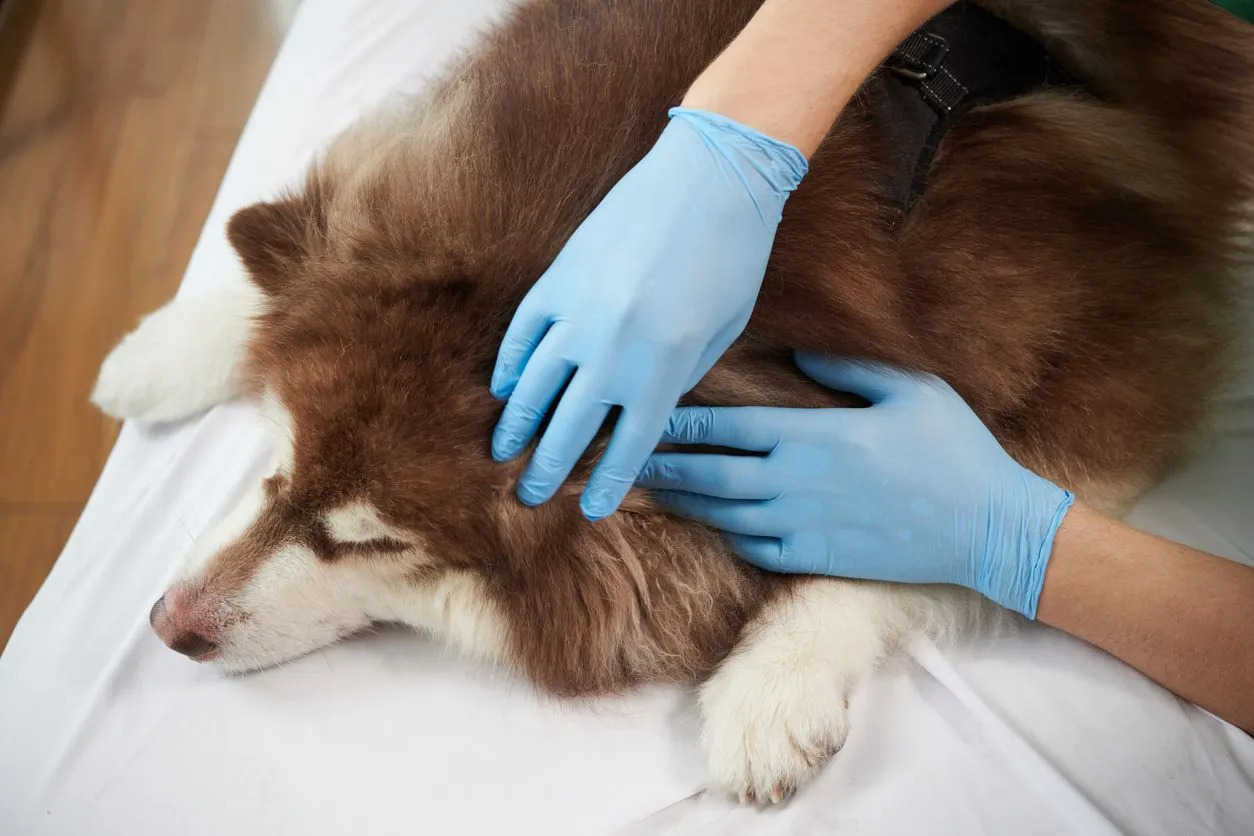Home>Health & Wellness>Common Health Issues>Why Dogs Scratch If There Are No Fleas


Common Health Issues
Why Dogs Scratch If There Are No Fleas
Modified: March 1, 2024
Learn why dogs scratch even when there are no fleas. Discover common health issues that may cause your pet to itch and how to address them.
(Many of the links in this article redirect to a specific reviewed product. Your purchase of these products through affiliate links helps to generate commission for Pawsomeoldies.com, at no extra cost. Learn more)
Table of Contents
Introduction
Have you ever noticed your furry friend scratching incessantly, even though you've diligently protected them from fleas? It can be quite perplexing to witness your dog's persistent scratching when there are no visible signs of fleas or other pests. This behavior often leaves pet owners wondering about the underlying reasons for their dog's discomfort.
Understanding the root cause of your dog's scratching is crucial for their well-being. While fleas are a common culprit, there are various other factors that can contribute to this behavior. By delving into the complexities of your dog's scratching, we can shed light on the potential reasons behind this puzzling phenomenon.
In this article, we will explore the multifaceted nature of your dog's itch, delving into both behavioral and environmental factors that may trigger excessive scratching. Additionally, we will delve into the potential health issues that could be causing discomfort for your beloved pet. By gaining a comprehensive understanding of these factors, you will be better equipped to address your dog's scratching and ensure their overall health and happiness.
Join us on this insightful journey as we unravel the mystery behind why dogs scratch when there are no fleas, empowering you with the knowledge to provide the best care for your canine companion.
Read more: Why Fleas Bite Dogs
Understanding the Itch
Understanding the itch that drives your dog to scratch relentlessly is essential for addressing their discomfort. While fleas are a common cause of itching in dogs, it's important to recognize that various other factors can trigger this behavior.
Firstly, it's crucial to comprehend that itching is a natural response for dogs. Just like humans, dogs experience itchiness due to a range of stimuli, including allergies, skin irritants, and even emotional distress. When your dog scratches, it's their way of attempting to alleviate the discomfort they are experiencing.
Moreover, the sensation of itching is complex and can be influenced by both internal and external factors. Internally, your dog's body may produce histamines in response to allergens, leading to itching. Externally, environmental factors such as dry air or irritants in their surroundings can also contribute to the itch.
Furthermore, the location of the itch can provide valuable insights. If your dog is scratching predominantly around their ears, it could indicate an ear infection or ear mites. On the other hand, itching concentrated around the paws might suggest allergies or contact with an irritant.
Understanding the itch goes beyond surface-level observation. It involves recognizing the intricate interplay of physiological, environmental, and behavioral factors that contribute to your dog's discomfort. By gaining a deeper understanding of the itch, you can take proactive measures to address the root cause and provide relief for your beloved canine companion.
Behavioral Reasons for Scratching
Behavioral reasons for scratching in dogs can stem from a variety of emotional and psychological factors. While it's common to associate scratching with physical discomfort, it's essential to recognize that behavioral issues can also manifest as excessive scratching in dogs.
One prominent behavioral reason for scratching is anxiety or stress. Dogs, like humans, can experience anxiety due to various triggers, including separation from their owners, changes in their environment, or exposure to loud noises. When dogs feel anxious or stressed, they may resort to scratching as a coping mechanism. This behavior can provide a temporary distraction from their emotional distress, offering a sense of relief amidst their unease.
Furthermore, boredom and lack of mental stimulation can also lead to excessive scratching in dogs. When dogs are under-stimulated or lack opportunities for physical and mental exercise, they may engage in repetitive behaviors such as scratching. This behavior serves as a form of self-soothing and can become habitual if the underlying cause of boredom is not addressed.
In some cases, scratching can also be a manifestation of attention-seeking behavior. Dogs are highly social animals and crave interaction with their human companions. When they feel neglected or yearn for attention, they may resort to scratching as a way to garner the focus and affection of their owners. This behavior can be reinforced if the dog receives attention, even if it's in the form of reprimands, when they scratch excessively.
Moreover, compulsive scratching, known as acral lick dermatitis or lick granuloma, can develop as a result of behavioral issues. This condition is characterized by incessant licking and scratching of a particular area, leading to skin damage and potential infection. Compulsive scratching often arises from underlying psychological distress, such as anxiety, frustration, or even obsessive-compulsive tendencies.
Understanding the behavioral reasons for scratching in dogs requires a holistic approach that considers their emotional well-being. By addressing underlying anxiety, providing ample mental and physical stimulation, and offering positive reinforcement for desirable behaviors, pet owners can help alleviate behavioral triggers that contribute to excessive scratching in their canine companions.
Environmental Factors
Environmental factors play a significant role in influencing your dog's scratching behavior. From the air they breathe to the surfaces they walk on, various elements in their surroundings can contribute to itchiness and discomfort. Understanding these environmental factors is crucial for identifying potential triggers and creating a more comfortable living environment for your furry friend.
One prominent environmental factor that can impact your dog's skin health is the air quality within your home. Dry air, particularly prevalent in heated indoor spaces during the winter months, can lead to skin dryness and itchiness in dogs. Similarly, exposure to airborne allergens, such as pollen, dust mites, and mold, can trigger allergic reactions in sensitive dogs, leading to excessive scratching and discomfort.
Moreover, the surfaces where your dog spends time, such as carpets, upholstery, and bedding, can harbor irritants and allergens that contribute to itching. Dust, dander, and other microscopic particles can accumulate in these areas, potentially exacerbating skin issues in dogs. Regular cleaning and maintenance of these surfaces can help minimize the presence of irritants, providing a healthier living environment for your pet.
Outdoor environmental factors also play a role in your dog's scratching behavior. Contact with certain plants, such as poison ivy or certain grasses, can lead to skin irritation and itching. Additionally, exposure to environmental pollutants, including pesticides and lawn chemicals, can have adverse effects on your dog's skin health, leading to discomfort and the urge to scratch.
Furthermore, the grooming products and cleaning agents used in your home can impact your dog's skin. Harsh shampoos, soaps, and detergents can strip the skin of its natural oils, leading to dryness and itchiness. Similarly, certain grooming products may contain ingredients that can trigger allergic reactions in dogs, resulting in skin irritation and persistent scratching.
By being mindful of these environmental factors, pet owners can take proactive measures to create a more skin-friendly environment for their dogs. This can include investing in air purifiers to improve indoor air quality, using pet-safe cleaning products, and being cautious about the outdoor environments where your dog roams. By addressing these environmental factors, you can help alleviate your dog's itching and promote their overall well-being.
Understanding and addressing environmental factors that contribute to your dog's scratching behavior is an essential aspect of providing comprehensive care for your canine companion. By creating a comfortable and skin-friendly environment, you can help minimize the triggers that lead to excessive scratching, ensuring a happier and healthier life for your beloved pet.
Health Issues
When exploring the reasons behind a dog's scratching behavior, it's crucial to consider potential health issues that could be contributing to their discomfort. While behavioral and environmental factors play significant roles, underlying health conditions can also manifest as excessive scratching in dogs. Understanding these health issues is essential for addressing the root cause of your dog's itch and ensuring their overall well-being.
One common health issue that can lead to persistent scratching in dogs is skin allergies. Dogs can develop allergic reactions to a variety of allergens, including pollen, dust mites, mold, and certain foods. These allergies often manifest as intense itching, redness, and skin irritation, prompting dogs to scratch excessively in an attempt to alleviate their discomfort. Identifying and managing these allergies through dietary adjustments, environmental modifications, and, in some cases, medication, can help alleviate the itching and improve your dog's quality of life.
Additionally, skin infections, such as bacterial or fungal infections, can contribute to itching and discomfort in dogs. These infections can result from underlying skin conditions, environmental factors, or compromised immune systems. Symptoms of skin infections may include redness, inflammation, and the presence of pustules or discharge on the skin. Prompt veterinary attention is crucial for diagnosing and treating skin infections effectively, often involving the use of topical or oral medications to combat the underlying infection and provide relief for the dog.
Furthermore, parasites such as mites and lice can infest a dog's skin, leading to intense itching and irritation. Sarcoptic mange, caused by the Sarcoptes scabiei mite, is a particularly notorious condition known for causing severe itching and skin inflammation in dogs. Similarly, infestations of lice can result in relentless scratching as dogs attempt to alleviate the discomfort caused by these parasites. Treatment for parasitic infestations typically involves veterinary-prescribed medications and thorough environmental cleaning to eradicate the parasites and relieve the dog's itching.
Moreover, underlying medical conditions, such as hormonal imbalances and autoimmune disorders, can manifest as skin issues that prompt excessive scratching in dogs. Hormonal imbalances, including thyroid disorders and Cushing's disease, can impact a dog's skin health, leading to dryness, hair loss, and itchiness. Autoimmune disorders, such as pemphigus and lupus, can also result in skin lesions and itching. Managing these underlying medical conditions often requires comprehensive veterinary care, including diagnostic testing and ongoing treatment to address the root cause of the dog's discomfort.
By recognizing and addressing these potential health issues, pet owners can take proactive steps to alleviate their dog's itching and promote their overall well-being. Seeking veterinary guidance and timely intervention is crucial for diagnosing and managing these health issues effectively, ultimately providing relief for dogs experiencing persistent scratching due to underlying medical conditions.
Read more: Why Are Fleas More Attracted To Dogs
Conclusion
In conclusion, the perplexing phenomenon of dogs scratching when there are no fleas can be attributed to a myriad of factors, encompassing behavioral, environmental, and health-related elements. Understanding the intricate nature of your dog's itch is pivotal for providing comprehensive care and addressing their discomfort effectively.
By delving into the behavioral reasons for scratching, we unveiled the emotional and psychological triggers that can drive excessive scratching in dogs. From anxiety and boredom to attention-seeking behaviors and compulsive scratching, the behavioral aspect of itching underscores the importance of addressing your dog's emotional well-being and providing ample mental stimulation and positive reinforcement.
Environmental factors also play a significant role in influencing your dog's scratching behavior. From indoor air quality and surface irritants to outdoor allergens and grooming products, the environment in which your dog resides can impact their skin health and contribute to persistent itching. By being mindful of these environmental factors and taking proactive measures to create a skin-friendly living environment, pet owners can help alleviate their dog's discomfort.
Furthermore, the potential health issues that can manifest as excessive scratching in dogs shed light on the importance of veterinary attention and timely intervention. Skin allergies, infections, parasitic infestations, and underlying medical conditions can all contribute to relentless scratching in dogs. Recognizing these health issues and seeking professional guidance is crucial for diagnosing and managing the root causes of your dog's itching, ultimately providing relief and improving their quality of life.
In essence, the mystery of why dogs scratch when there are no fleas encompasses a complex interplay of behavioral, environmental, and health-related factors. By gaining a comprehensive understanding of these elements and taking proactive steps to address them, pet owners can ensure the well-being and comfort of their beloved canine companions. Through attentive care, environmental mindfulness, and veterinary support, the enigma of excessive scratching can be unraveled, paving the way for a happier and healthier life for dogs everywhere.














